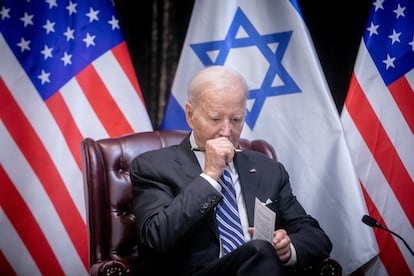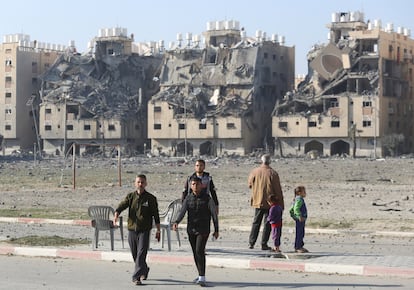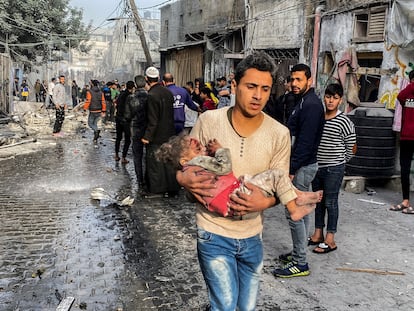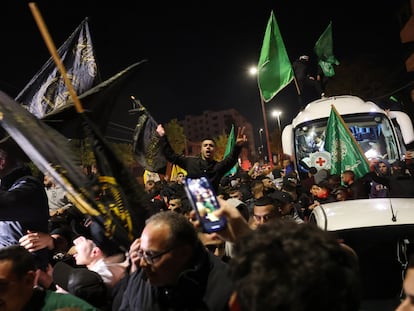Israeli offensive in southern Gaza puts US leverage to the test
European countries like Germany, Austria and Hungary maintain a mostly unwavering support for Netanyahu’s government despite criticism from Spain, Ireland, Luxembourg and Belgium

The United States is standing with Israel on “its duty and responsibility” to defeat Hamas, President Joe Biden’s administration publicly insists. However, while outwardly expressing its support for Israel and blaming the radical Palestinian militia for the collapse of the pause in the hostage exchange, behind the scenes Washington is pressuring its ally to change tactics in its war in Gaza. The second phase of the offensive, in the south of the Strip, Washington insists, must involve greater protection for a civilian population that is even more concentrated in a smaller area.
The return to hostilities, and especially Israel’s conduct, provides a stern test for the United States. Biden’s administration insists that the strategy of “embracing” Israel, pursued since the outbreak of the crisis, is the correct one and allows it to exert pressure on the behavior of the Israeli government. It points to the entry of humanitarian aid into the Strip or the seven-day ceasefire that Netanyahu had initially dismissed outright, among other factors.
In this position, the U.S. is not alone. In the European Union, which maintains that Israel has the right to defend itself while respecting international law, there are member states, such as Spain, Belgium, Ireland and Luxembourg, which have been much more critical of the violations committed by Benjamin Netanyahu’s government. And others, like the Czech Republic, Austria, Germany — but with some nuance — and Hungary, which support Israel almost unwaveringly and have led the opposition within the EU to a joint call for a sustained humanitarian ceasefire.
However, the resumption of bombing since Friday, and Israel’s withdrawal of its negotiators in Qatar, calls into question the extent to which Washington can exert control over its ally.
Nathan Sachs, director of the Center for the Middle East at the Brookings Institution, says via video call: “The pressure is very much focused on having a plan for what [Israel] wants to do.” He adds: “Israel has partially completed its aims in the north of Gaza; now the question is the south, where there is a large number of people: not only its residents, but also refugees from the north, so what is going to happen now?” The south is now home to 80% of the Strip’s 2.3 million inhabitants, after bombing in the north forced most of the residents there to escape.
During the seven-day ceasefire, and even before, U.S. officials had insisted that they would only back an Israeli military offensive in the southern Strip if it was combined with measures to protect civilians, prevent further mass displacements of the population and not target basic infrastructure, especially hospitals. The Biden administration does not seem prepared for the second phase of the fighting to match the levels of death and destruction left by the first stage in the north. According to figures from the Ministry of Health in the Strip, which the U.N. believes is credible, more than 15,000 Palestinians, many of them children, have been killed by Israeli bombing.
This is a message that Biden himself previously conveyed directly to Netanyahu in their most recent conversation last weekend, and which Secretary of State Antony Blinken, during his lightning tour of the Middle East this week, reiterated to the Israeli war cabinet on Thursday. “We addressed the details of the Israeli planning and I stressed that it is imperative for the United States that large-scale loss of civilian life and [forced] displacement on the level we saw in northern Gaza may not be repeated in the south,” the Secretary of State stressed after the meeting.
Among other things, Washington has called on Israel to reduce the area of fighting and to inform Palestinian civilians where they can seek shelter from the bombardment in the southern area. National Security Council spokesman John Kirby pointed out this week that U.S. military advisers have briefed Israeli commanders on the experiences of U.S. soldiers in urban combat in places like Fallujah and Mosul during the Iraq War, to ensure that the allied country’s forces do not make the same mistakes.
“Israel has one of the most modern armies in the world. It is capable of neutralizing the threat posed by Hamas while minimizing the damage to innocent men, women and children,” Blinken said at a press conference in Tel Aviv after his meeting with the Israeli war cabinet.
Furthermore, the U.S. is also trying to plan possible ways out of the conflict with Israel and with the Arab states. This is a prospect that it had hoped might be boosted by the ceasefire, but which now seems more complicated than ever. Washington advocates a two-state solution, negotiated between Israel and a revitalized Palestinian Authority; a move that differs from the desire of the right-wing Netanyahu government.
“Israel refuses to discuss at length what will happen after the conflict,” says Itamar Rabinovich, former Israeli negotiator with Syria and former ambassador to Washington, now an analyst at Brookings, also speaking by video call. However, “the only viable solution is for the Palestinian Authority to return to Gaza, from where it was expelled by Hamas in 2007. This is an anathema to the Israeli Right.”
Steven Cook, of the Council on Foreign Relations, told reporters, “the outcome, if there is one, is likely to be an occupation of the Gaza Strip for a certain period of time. The Israelis have made it clear that they want to establish a security regime there.”

On the ground, NGOs and the civilian population denounce that the bombings have recommenced more strongly than before. The death toll since the ceasefire breakdown is already in the hundreds. At the same time, the U.S. continues to supply armaments to its ally. According to The Wall Street Journal, these shipments have included 15,000 bombs and 57,000 artillery rounds in the last two months, including a hundred large bunker busters each weighing one ton.
A return to the tactics employed in the first phase of the war would place the U.S. in a sticky situation. In addition to criticism from abroad, particularly from Arab countries, about its ties to Israel, the Biden administration must contend with calls from the progressive wing of the Democratic Party and some labor unions for a permanent ceasefire.
The Muslim and Arab American community — which is small but pivotal in key swing states such as Virginia and Michigan and which in 2020 overwhelmingly supported Biden — is threatening to abstain in next year’s presidential election. This could have serious consequences for the Democrats. There are divisions even within the Biden administration — as evidenced in meetings and open letters of protest — over whether it is wise to give an apparent blank check to the Netanyahu government.
Even U.S. public opinion seems to be shifting away from the unconditional support for Israel it expressed after the Hamas attacks of October 7, resulting in the deaths of 1,200 Israeli citizens. A Gallup poll shows that 50% — including 71% of Republican voters — support the Israel Defense Forces’ offensive, while 45% oppose it. Six in ten Democrats profess opposition to the military campaign.
In the European countries that support Israel, this position also remains, even though the breaking of the truce has weakened this support. Meanwhile, the tone towards Netanyahu among some of his allies, such as France, has toughened. Citizen demonstrations have also intensified in response to the appalling images coming from the Gaza Strip.
Israel’s closest supporters within the EU claim that the bloc and several member states with strong relations with Israel have urged Netanyahu to hold back on attacks on Gaza. In response to concerns, Israel said that it is focusing its attacks as much as possible. However, as the weeks go by and the Strip is once again in a critical situation, the Gaza bloodshed has once again highlighted a division in the EU that is unlikely to disappear, at a time when Brussels is starting to talk about what happens after the conflict.
Sign up for our weekly newsletter to get more English-language news coverage from EL PAÍS USA Edition
Tu suscripción se está usando en otro dispositivo
¿Quieres añadir otro usuario a tu suscripción?
Si continúas leyendo en este dispositivo, no se podrá leer en el otro.
FlechaTu suscripción se está usando en otro dispositivo y solo puedes acceder a EL PAÍS desde un dispositivo a la vez.
Si quieres compartir tu cuenta, cambia tu suscripción a la modalidad Premium, así podrás añadir otro usuario. Cada uno accederá con su propia cuenta de email, lo que os permitirá personalizar vuestra experiencia en EL PAÍS.
¿Tienes una suscripción de empresa? Accede aquí para contratar más cuentas.
En el caso de no saber quién está usando tu cuenta, te recomendamos cambiar tu contraseña aquí.
Si decides continuar compartiendo tu cuenta, este mensaje se mostrará en tu dispositivo y en el de la otra persona que está usando tu cuenta de forma indefinida, afectando a tu experiencia de lectura. Puedes consultar aquí los términos y condiciones de la suscripción digital.
More information
Archived In
Últimas noticias
Most viewed
- Reinhard Genzel, Nobel laureate in physics: ‘One-minute videos will never give you the truth’
- Oona Chaplin: ‘I told James Cameron that I was living in a treehouse and starting a permaculture project with a friend’
- Pablo Escobar’s hippos: A serious environmental problem, 40 years on
- Charles Dubouloz, mountaineering star, retires at 36 with a farewell tour inspired by Walter Bonatti
- Why we lost the habit of sleeping in two segments and how that changed our sense of time










































